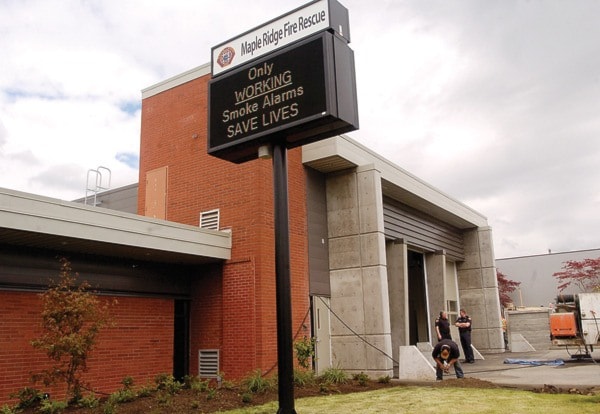Maple Ridge’s growing police and fire department bills continue to eat up a sizable chunk of taxpayers’ money, an amount that next year will become almost half of the district’s total take.
From the $60 million the district will raise in taxes 2012, the RCMP bill will take $17.6 million, while $10 million will go to the Maple Ridge Fire Department.
According to the financial plan OK’d by council Tuesday, the Maple Ridge Fire Department now has 47 full-time members and 95 more who are paid on-call.
In 2012, the number of full-time firefighters will increase again (by how many is not yet known), contributing to an overall salary increase of 11 per cent.
Regardless of the number hired, 2012 will be the last year of a multi-year expansion to a combined full-time/paid-on-call department. After that, hiring will be done mostly to maintain numbers, explained fire chief Peter Grootendorst.
Moving to the full-time/part-time model, away from one which relied mainly on paid volunteers, has allowed quicker response times in the urban area. One of the challenges of remaining a volunteer force was the difficulty in getting sufficient manpower to fight a fire, when volunteers were working out of town.
Now, with full-timers around all the time, firefighters can get to a kitchen fire while it’s still a kitchen fire, Grootendorst said.
“The value has been shown to be tremendous, just in having the ability to get there quicker.”
Firefighters also go to most motor vehicle accidents, primarily for safety reasons, cleaning up fuel spills, removing downed wires, performing traffic control or dealing with air bags. If B.C. Ambulance isn’t on scene, firefighters also take over medical duties.
“There’s a ton of stuff we can almost always do at an accident,” the chief said.
Within the Fire Hall No. 1 area, firefighters now get to calls within seven minutes, 82 per cent of the time. Its target is 90 per cent.
Five years ago, when the department was staffed mainly by paid on-call volunteers, they only got to 44 per cent of the calls within that time.
Fire Hall No. 3 is now also staffed around the clock with response times approaching Hall No. 1. Because Hall No. 1 has to cover the Albion area, which is slated to get a new fire hall at 240th and 112th Avenue, it’s not possible to hit 90 per cent range, Grootendorst explained.
Meanwhile, according to fire department summary in the financial plan, a “noticeable change in weather patterns over the past several years,” has resulted in more floods and fires to which the department has responded.
An aging population means firefighters also have to respond to more medical calls.
Under the current set up, the fire department only responds to the most serious emergencies or if B.C. Ambulance can’t respond.
“If it’s that serious a call, then generally having a few extra hands helps out the ambulance service, as well.”
RCMP costs will also climb a million next year, to pay wages and benefits and three new officers, bringing the current contingent to 87 serving Maple Ridge.
However, the district will still have to find another $750,000 which will pay for an impending retroactive wage increase of two or three per cent. That could come from a reserve account to spare a hit to the general finances.
The financial plan calls for an average 5.57-per-cent increase in property taxes in 2012, or about $131 for an average home.
That’s something newly elected councillor Corisa Bell wants to change next year. She wants to see the public presented with other scenarios where taxes are raised only one or two per cent and will talk to staff about that.
“I don’t agree with the tax increases. I do feel that we can get creative, we can come up with something. People are still unable to afford land tax increases at this rate, on an annual basis,” she added.
“Something needs to be looked at and I look forward to seeing what I can do about it.”
Mayor Ernie Daykin would consider alternative scenarios for tax increases. “I don’t have a problem looking at it. To hit two per cent, what do we need to do – cut, cut, cut – and are people willing to accept that?” he said.
“I’m not in denial that I don’t think people are concerned about tax increases.”
Police and fire services, he added, are most municipalities’ biggest costs.
